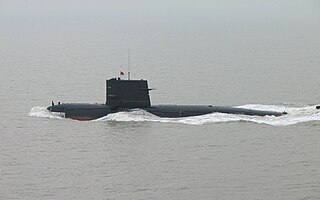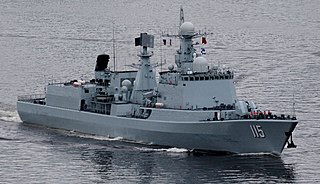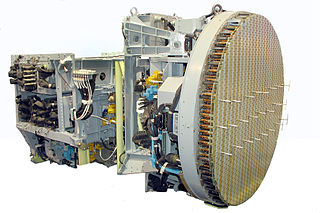
Type 366 radar is the Chinese development of Russian MR-331 Mineral-ME naval radar (NATO reporting name: Band Stand), and as late as the 2010s, it is the latest and most advanced surface search radar of the Chinese navy.

Type 366 radar is the Chinese development of Russian MR-331 Mineral-ME naval radar (NATO reporting name: Band Stand), and as late as the 2010s, it is the latest and most advanced surface search radar of the Chinese navy.
MR-331 Mineral-ME radar system consists of Mineral-ME1 active radar and Mineral-ME2 passive radar mounted in a back-to-back configuration, and Mineral-ME3 mutual data exchange, navigation and joint combat operation control station, [1] Mineral-ME radar system is designed to detect, track and record (including over-the-horizon) surface targets, provide and receive information to and from other sources. [1] Typical detection range against a destroyer sized target in the active mode in up to 250 km, while that of the passive mode ranges from 80 to 450 km. [1] Active and passive subsystems of MR-331 Mineral-ME can operate in conjunction. MR-331 Mineral-ME is installed on Sovremennyy-class destroyer sold to China, and China also purchased additional sets for its own destroyers.
China was thoroughly impressed by the performance of Russian MR-331 Mineral-ME naval radar and proceeded to develop its own version designated as Type 366. The major Chinese modification of the Russian system is in the data exchange and operator console, where China has improved mode of operations. [2] Like its Russian predecessor, Type 366 radar operates in five different frequency bands and when working in the active mode, the number of targets can be handled is three times of that of when in passive mode. [1] Type 366 radar is claimed to be superior than its Russian predecessor is when active and passive subsystems work in conjunction. [2] In comparison to the original surface search function of its Russian predecessor, China expanded the functions on Type 366 radar by also using it as a low-altitude 2-D air search radar against sea-skimming anti-shipping missiles. With improved software, Type 366 radar is proven to be effective against sea-skimming target with radar cross section of 0.1 to 1 square meter by detecting such incoming targets at distance of 20 to 35 km range. [2]

The Phalanx CIWS is a gun-based close-in weapon system to defend military watercraft automatically against incoming threats such as aircraft, missiles, and small boats. It was designed and manufactured by the General Dynamics Corporation, Pomona Division, later a part of Raytheon. Consisting of a radar-guided 20 mm (0.8 in) Vulcan cannon mounted on a swiveling base, the Phalanx has been used by the United States Navy and the naval forces of 15 other countries. The US Navy deploys it on every class of surface combat ship, except the Zumwalt-class destroyer and San Antonio-class amphibious transport dock. Other users include the British Royal Navy, the Royal Australian Navy, the Royal New Zealand Navy, the Royal Canadian Navy and the US Coast Guard.

An anti-ship missile (AShM) is a guided missile that is designed for use against ships and large boats. Most anti-ship missiles are of the sea skimming variety, and many use a combination of inertial guidance and active radar homing. A good number of other anti-ship missiles use infrared homing to follow the heat that is emitted by a ship; it is also possible for anti-ship missiles to be guided by radio command all the way.

The SAMPSON is a multi-function dual-face active electronically scanned array radar produced by BAE Systems Maritime. It is the fire control radar component of the Sea Viper naval air defence system. The Sea Viper system is also known as PAAMS(S) to denote the use of the SAMPSON radar and to distinguish it from the PAAMS system on the Franco-Italian Horizon-class frigate.

The Delhi-class destroyers are guided-missile destroyers of the Indian Navy. Three ships of this class are in active service. The Delhi-class vessels were the largest vessels to be built in India at the time of their commissioning. The ships were built by Mazagon Dock Limited (MDL) at a cost of ₹750 crore each.

The HQ-16 is a medium range semi-active radar homing surface-to-air missile developed by the People's Republic of China.

The Type 051B destroyer is a class of destroyer built by the People's Republic of China. It consists of only one ship, Shenzhen (167). When Shenzhen was commissioned into the People's Liberation Army Navy Surface Force in 1998, it was then the largest surface combatant that China had ever built. It resembles in many ways an enlarged version of the Luhu-class destroyer, and is one of the first PLAN ships with a slope-sided hull to reduce radar signature. The Type 051B was succeeded by the domestic Type 052B destroyer, discounting the 4 Soviet-built Sovremenny-class destroyer that China purchased in the interim.

A stealth ship is a ship that employs stealth technology construction techniques in an effort to make it harder to detect by one or more of radar, visual, sonar, and infrared methods.

The Kh-31 is a Russian air-to-surface missile carried by aircraft such as the MiG-29 or Su-27. It is capable of Mach 3.5 and was the first supersonic anti-ship missile that could be launched by tactical aircraft.

The Type 730 is a Chinese seven-barrelled 30 mm Gatling gun/Rotary cannon CIWS. It has a PLA Navy designation H/PJ12. It is mounted in an enclosed automatic turret and directed by radar, and electro-optical tracking systems. The maximum rate of fire is 5800 rd/m, and the effective range is up to 3 km.

Gabriel is a family of sea skimming anti-ship missiles manufactured by Israel Aerospace Industries (IAI). The initial variant of the missile was developed in the 1960s in response to the needs of the Israeli Navy which first deployed it in 1970. Since then, variants have been exported to navies around the world. The latest variant, the Gabriel V, is in use by the Finnish and Israeli navies as of 2020.

The Type 039 submarine is a class of diesel-electric submarines of the People's Liberation Army Navy. The class is the first diesel-electric submarine to be fully developed within China and also the first Chinese diesel-electric submarine to use the modern teardrop hull shape.
The People's Liberation Army Navy (PLAN) is the naval branch of the People's Liberation Army (PLA), the armed forces of the People's Republic of China. The PLAN force consists of approximately 250,000 men and over a hundred major combat vessels, organized into three fleets: the North Sea Fleet, the East Sea Fleet, and the South Sea Fleet.

The Type 051C destroyer is a long-range air-defence guided-missile destroyer built by China in its ongoing effort to create a true blue water navy. The ship uses the hull design of the older Type 051B, but is equipped with the advanced Russian S-300FM air defence missiles systems. Currently, two ships of this class have been launched and deployed by People's Liberation Army Navy North Sea Fleet.

The Sukhoi Su-30MKK is a modification of the Sukhoi Su-30, incorporating advanced technology from the Sukhoi Su-35 variant. The Su-30MKK was developed by Sukhoi in 1997, as a result of a direct Request for tender between the Russian Federation and China. It is a heavy class, all-weather, long-range strike fighter, and like the Sukhoi Su-30, comparable to the American McDonnell Douglas F-15E Strike Eagle. Su-30MK2 is a further improvement to Su-30MKK with upgraded avionics and maritime strike capabilities. The MKK and MK2 are currently operated by the People's Liberation Army Air Force, Indonesian Air Force, Vietnam People's Air Force, Venezuelan Air Force and the Ugandan Air Force.

The Zhuk are a family of Russian all-weather multimode airborne radars developed by NIIR Phazotron for multi-role combat aircraft such as the MiG-29 and the Su-27. The PESA versions were also known as the Sokol.

The Bars (Leopard) is a family of Russian all-weather multimode airborne radars developed by the Tikhomirov Scientific Research Institute of Instrument Design for multi-role combat aircraft such as the Su-27 and the MiG-29.

The Sovremenny class, Soviet designation Project 956 Sarych (buzzard), is a class of anti-ship and anti-aircraft guided-missile destroyers of the Soviet and later Russian Navy. The ships are named after qualities, with "Sovremenny" translating as "modern" or "contemporary". Most of the ships have been retired from active service and one converted into a museum ship in 2018; as of 2021 three remain in commission with the Russian Navy with several in overhaul. Four modified ships were delivered to the People's Liberation Army Navy, and remain in service.
Cooperative Engagement Capability (CEC) is a sensor network with integrated fire control capability that is intended to significantly improve battle force air and missile defense capabilities by combining data from multiple battle force air search sensors on CEC-equipped units into a single, real-time, composite track picture. This will greatly enhance fleet air defense by making jamming more difficult and allocating defensive missiles on a battle group basis.

Shenyang (115) is the lead ship of Type 051C destroyer of the People's Liberation Army Navy. She was commissioned on 1 January 2006.

Shijiazhuang (116) is second ship of Type 051C destroyer of the People's Liberation Army Navy. She was commissioned on 22 January 2007.